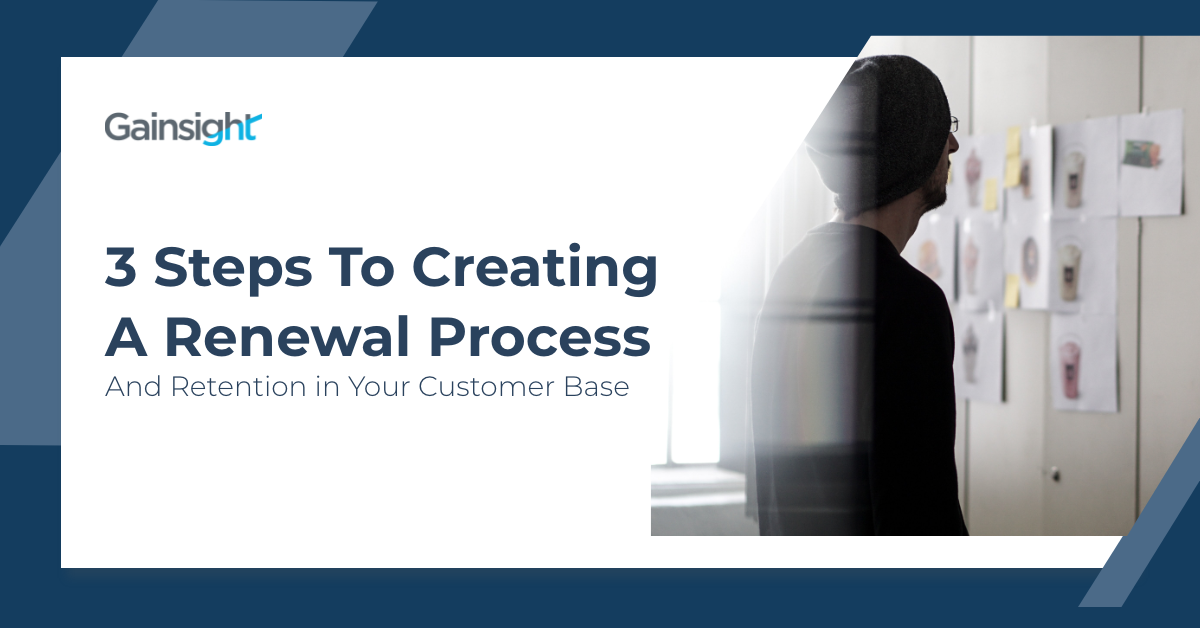In the current, increasingly complex economic situation, many CFOs, and others in the organization are reviewing key metrics—particularly Cost of Retention and Customer Acquisition Cost. According to research, a modest bump of 5% improvement in retention can result in anywhere from 25% – 95% increase in profits. In these uncertain times, those stats are not to be taken lightly.
KBCM Technology Group’s 2020 SaaS Survey Results indicate that the cost to acquire one dollar of new customer Annual Recurring Revenue (ARR) is $1.60., while the cost to expand an existing customer is only 69 cents. Gainsight has been preaching this point for some time—customer acquisition isn’t enough for your company to stay ahead of the competition. To successfully drive real growth for your business, you must focus on preserving and expanding the customers you already have.
The Purpose Behind The Process
A focus on retaining customers comes with its own challenges. Behind every renewal is a person. That person has likely been a user of convenient consumer products and translates their experience with those products into heightened expectations for your organization. Instead of the adage “Always be selling (ABS),” organizations must shift to the mantra, “Always be retaining (ABR).” This is especially true now that we’re all facing an economic downturn and budget scrutiny is at a high.
To effectively improve retention, companies need to have a defined process in place to manage renewals. Your team will be more efficient in their day-to-day and ensure that nothing slips through the cracks when renewal time comes along. Additionally, it will also allow them to deliver a more consistent and positive customer experience for your customers.
Here are three steps to follow to put an effective renewal process in place for your business.
1. Determine What At-Risk Means And How To Monitor For It
Risk should be the foundation for any renewal strategy. By identifying risk in your customer base, your team will drive action to mitigate it faster and help drive up retention. Naturally, the first step of establishing a renewal process is defining the leading indicators of risk within your customer base. They could include:
- Change of an executive sponsor
- The number of support tickets opened
- A drop in usage of your product or key features
- Negative survey responses or low NPS/CSAT
- Missed onboarding, adoption, or lifecycle milestones
- Lack of perceived value by your customer. This includes shifting priorities within your customer’s business, which are likely during this economic downturn.
- Lack of visibility or missing indicators that can escalate the possible churn of a customer
And it’s important to consider how these leading indicators change between customer segments or lifecycle stages.
But merely identifying those indicators is not enough – it’s essential to have a system in place to monitor for these signals and automatically alert your customer success team when they appear. This system should also understand which signs are most important or indicative of customer health, and treat those signals differently.
An excellent tool for assessing risk is your customer success platform’s health scorecard. Leveraging your Customer Success (CS) platform to monitor health and identify at-risk customers will allow your team to resolve any issues and not face surprises come renewal time. Some examples of measures we see commonly included in Scorecards are:
- Engagement frequency, including executive engagement
- Product usage or license utilization
- Support tickets (number of opened tickets and priority)
- Customer sentiment (e.g. NPS, CSAT)
- CSM assessment
- Return on Investment (ROI)
If you’ve already established a basic health scorecard and are ready to take it to the next level, incorporate signals from sources outside of the customer data you collect in your CS platform. These signals include important news and business driving events, such as acquisitions, funding rounds, CEO changes, or financial losses that occur at a customer account. Gainsight’s Company Intelligence feature allows you to do this effortlessly by monitoring external sources for this information and proactively alerting your Customer Success Managers (CSMs) of news and events related to their customer accounts. They can quickly understand whether this news introduces risk at their account and take the right accounts to mitigate it.
2. Drive the Right Actions to Close Every Renewal
After you establish a way to identify risks within your customer base, you need to define a standardized plan of action or a playbook that enables your team to mitigate risks before a renewal cycle. Playbooks help your team be more proactive in managing renewals and provide step-by-step guidance on the actions your team should take to close the renewal.
A classic example of a renewal playbook is one that is triggered based on a customer’s renewal date – creating a Call-to-Action that alerts the CSM to the upcoming renewal and outlines the next steps that need to be taken, such as:
- Reviewing the original contract, as well as the customer’s 360 and current product usage metrics
- Aligning with the Account Manager on a renewal strategy
- Contacting the customer’s decision-maker or executive sponsor to discuss the renewal
- Sending out a proposal
- Following up with a ‘thank you’ note
Playbooks for at-risk and healthy customers might look slightly different, but it’s essential to establish a standardized way to handle all types of renewals. They help your team build consistency into their workflows, collaborate more effectively with other teams working on the renewal, and ensure that no missed critical steps during the process.
Once you nail down standardized renewal processes, you can uplevel your renewal management strategy by creating a centralized command center for renewals and focusing on stakeholder alignment. Solutions like Gainsight’s Renewal Center give you the tools you need to do this effectively. Renewal Center surfaces renewal opportunities that need attention—such as those at risk, missing for your forecast, and that are likely to close late – helping your team prioritize their workload and take action on these opportunities faster. People Maps helps ensure that your team is aligned with every stakeholder involved in the decision-making process. It gives everyone visibility into the decision-makers’ reporting structure, the contacts that influence their decision, and the tone of the sentiment for every contact.
3. Power improved retention at scale
The key to driving a lasting and meaningful impact on customer retention metrics is scaling your processes properly. For most companies, this is where CS technology can have the most significant impact.
Automated workflows can help your team work more efficiently and engage your customer base throughout the entire customer lifecycle. That’s why our customers love our Journey Orchestrator feature. It allows you to automate the renewal process for specific segments (e.g., long-tail) frees your team up to focus on the accounts that require more attention, such as those at-risk accounts.
If you’re ready and want to kick your renewal process up a notch, you can leverage Gainsight’s centralized command center for managing renewals. Renewal Center makes it simple and easy for you to keep an eye on hundreds (or even thousands) of renewal opportunities within a single dashboard. Your team can streamline weekly forecast meetings, keep leadership apprised of what’s happening with your renewal book of business, and create more accurate forecasts to enhance your renewal management process. Inline editing and one-click access to key CS insights for every opportunity ensure better collaboration and alignment between sales, CS, and any other team working on renewals. This collaboration drives significant retention and efficiency for your business.
Making Customer Success Better With Renewal Optimization
Putting processes in place to manage renewals and increase retention does not need to be a daunting task. In working with our customers and internal teams, we’ve seen that sometimes it’s best to take a phased approach. First and foremost, define a standard process and find the right tools to support it, such as Gainsight’s Customer Success solutions. And from there, you can focus on identifying areas of that process that can be improved or optimized over time as your strategy matures.
With Gainsight’s Revenue Optimization solutions, you bring your “A” game to the table every time a renewal opportunity arises. By utilizing these solutions, you can optimize renewal management with a centralized command center, improve stakeholder alignment, and stay on top of important customer updates to ensure your preparation for every renewal conversation. If you are ready, we are waiting for you to help you “level up” for your next renewal adventure and increase your customer retention.
Get Started
Ready to experience the speed, handling, and agility of the market’s leading Customer Success Platform? Take Gainsight for a Joyride today.

